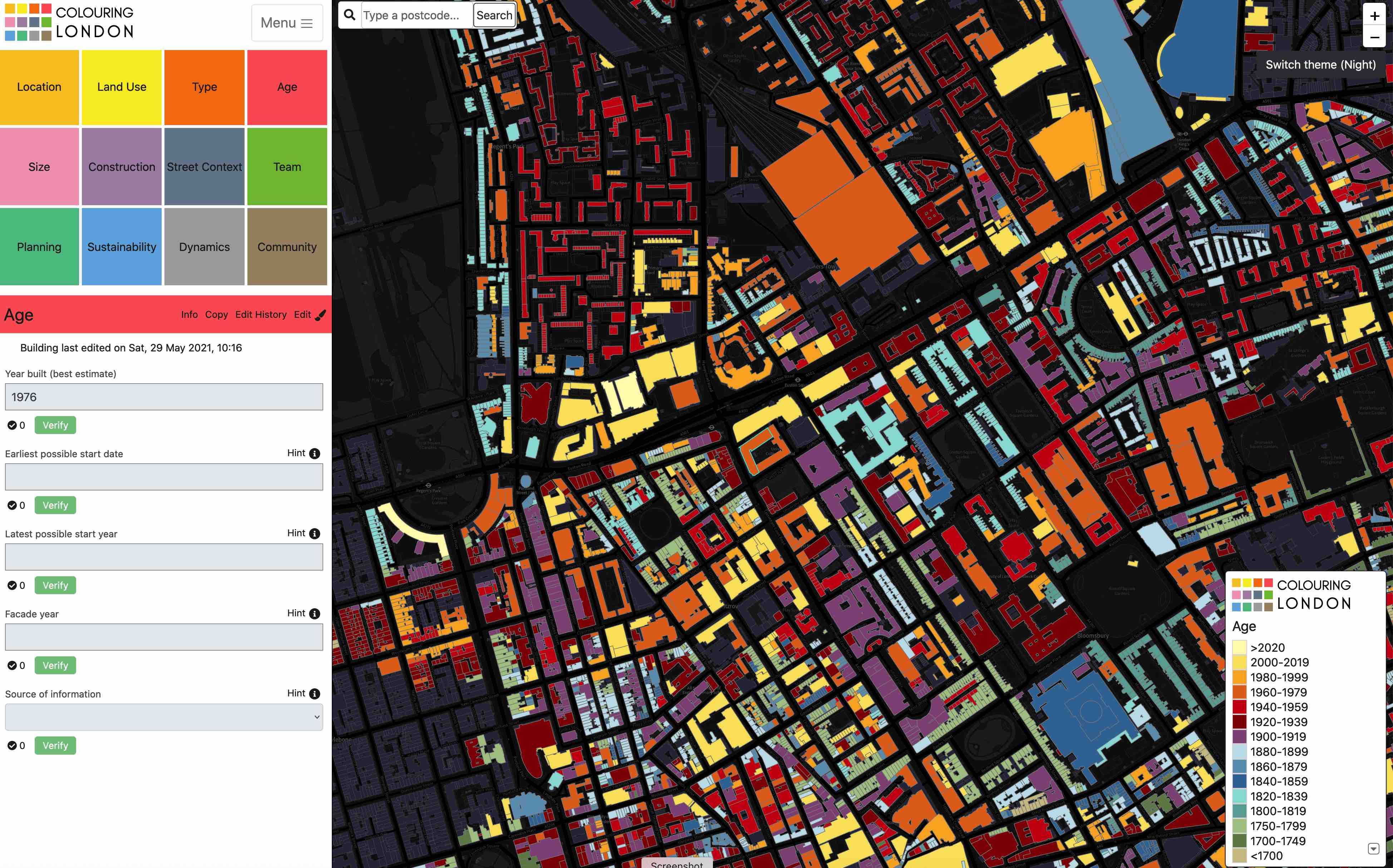
www.buildingsandcities.org/insights/research-pathways/harnessing-spatial-data.html
Harnessing the Power of Spatial Data
RESEARCH PATHWAY: personal reflections on a career in research
Polly Hudson (Alan Turing Institute) explains how her curiosity about planning knowledge and local community engagement led to new ways to capture and represent 2D, 3D and 4D spatial data about building stocks and urban form. New challenges arise for creating dynamic urban models and platforms: promoting public participation and understanding, use as a planning tool, combining diverse data sources, and simulating the behaviour of building stocks over time.
At university, I studied art and architectural history, although I was always much more interested in learning about how and why places were built, than in artists' and architects' lives. This experience encouraged me to ask questions about the process by which ordinary buildings are produced, and the reasons for their construction and form. My interest, as a designer and researcher, is how to create inclusive, interesting, accessible and useful resources on building stocks. This entails harnessing the skills and knowledge from many types of audience.
I grew up in a family involved in medical research which exposed me to the value of international collaboration in scientific research. An important influence was the connection between the diagnosis / treatment of disease and the technological innovation in microscopy that advanced the understanding of biological systems. Realising how buildings could be studied like 'cells' using Geographic Information Systems (GIS) was a major turning point in my career. The capture of spatial statistics at cell level on the composition, dynamics and operation of stocks is necessary to understand urban systems. This led to a particular interest in building footprints, both as graphic representations of building 'cells', past and present, as geospatial filing cabinets through which diverse types of data can be collated, and as attributes from which other characteristics can be inferred. The Periodic Table and its use of simple 2D graphic to infer properties, structure and reactions of the chemical elements make data has been another source of inspiration. Could the possibilities offered by graphic representation be used to forecast the future dynamic behaviour of stocks?
In 1995 I took a part time job looking at planning applications on behalf of a local conservation group. I decided to produce coloured maps showing the age of buildings in that district, finding it inexplicable that maps of this kind did not already exist. I was also struck by planners' lack of interest in residents' views on planning applications or in the impacts of demolition on local communities, when so much knowledge on how local areas operate over time is held by these communities and conservation groups.
I initiated The Building Exploratory charitable trust in London to harness and visualise community knowledge about building stocks. This involved a process of co-creation with local stakeholders to produce a model of local building stocks for free public exhibitions/resource centres, which combined physical and digital tools. This brought together expertise from the arts, humanities and science to explore building construction and design, performance and history. Here I also began to explore the use GIS, and data animations, as a means to rapidly convey information on buildings to the public. Providing users with the ability to zoom down on their homes and access current and historical maps, aerial photography, and streetview images at building level was found to be of exceptional interest to visitors (tested before Google maps became available). Since this time my work has largely focused on the development of spatial data visualisations as a powerful, efficient way to support public engagement in sustainable development.
Experimentation with Steve Evans in the early 2000s, before collaborating again at University College London (UCL), resulted in several projects which informed later work including a 3D digital animation of the demolition and construction of all buildings in a 1km2 area of London, between 1750 and 2010 and an animated history of fossil fuel use in the UK.
In 2014 I commenced a PhD at UCL,
initially to look at methods for tracking demolition in the UK. This multidisciplinary
academic environment exposed me to an incredibly diverse range of expertise. However,
owing to lack of availability of basic data to answer my research question, I instead
began to explore the methods and technologies that could capture and visualise data
on demolition, and on the composition, quality and short- and long-term
dynamics of the building stock. This involved experimenting with the use
of building footprint data to help harness and share knowledge. The goal was to
allow the public and other stakeholders to see and become involved with building
attribute data capture and visualisation for UK cities at cell level, and to
seamlessly interlink information on stock composition, performance and dynamic
behaviour. 
As part of my PhD I began to work on the development the Colouring London prototype platform, collaborating with Tom Russell, the project's technical architect. The idea was to integrate tools, ethical frameworks and crowdsourcing mechanisms, with the co-creation model and ethical framework developed at the Building Exploratory. This also afforded opportunities to develop an open platform involving multiple sectors, disciplines and stakeholders in supporting the scientific analysis of stocks. Many possible applications for proposed attribute data were identified (e.g. improved retrofit targeting, performance tracking of development teams, more accurate calculations of energy and waste flows, greater transparency within the planning system). However, the initial focus was mainly on the ability of the platform to capture high quality age data for typology location and energy analysis.
Questions began to arise on how a sufficient quality and volume of (current and historical) microspatial data could be produced in order to understand the stock as a complex dynamic system, and to detect underlying rules of operation within stocks. Automated and crowdsourced methods of data capture therefore started to be tested as well as feedback loops between these. These include mechanisms that enable humanities experts to easily translate text-based information and unrecorded knowledge into spatial statistics for scientific use.
The Colouring London project moved to the Alan Turing Institute in 2020 becoming The Colouring Cities Research Programme (CCRP). Its remit is to promote the efficient reproduction of open-source platform code by international academic partners to maximise the volume and quality of building attribute data available at global level. We currently work with an international cohort of academic colleagues to test code across countries, share software engineering skills and knowledge on different aspects of the stock. The goal is to improve the effectiveness and efficiency of platforms.
Challenging questions that still need to be addressed include:
- How can the ease of reproducibility of open code be improved to maximise access - especially for countries with limited funds and research software engineering expertise?
- How can the development of core-code and interface design allow countries to co-work on the analysis of captured data?
- How can this be done in a way that also promotes high standards of data ethics?
- How can the process of producing high quality, large-scale datasets be accelerated? Can feedback loops between automated data capture and crowdsourced contributions be designed to ensure the efforts of contributors are not automatically overwritten?
- How can data be captured on short- and long-term dynamics for use by digital twins that can simulate the demolition and construction of buildings over time?
- How can Colouring Cities data be used to explore underlying spatio-temporal patterns, rules and cycles operating with stocks, and across countries?
- How can 4D visual databases be developed for cities while protecting the current and future privacy and security of citizens?
Latest Peer-Reviewed Journal Content
Designing for pro-environmental behaviour change: the aspiration–reality gap
J Simpson & J Uttley
Lifetimes of demolished buildings in US and European cities
J Berglund-Brown, I Dobie, J Hewitt, C De Wolf & J Ochsendorf
Expanding the framework of urban living labs using grassroots methods
T Ahmed, I Delsante & L Migliavacca
Youth engagement in urban living labs: tools, methods and pedagogies
N Charalambous, C Panayi, C Mady, T Augustinčić & D Berc
Co-creating urban transformation: a stakeholder analysis for Germany’s heat transition
P Heger, C Bieber, M Hendawy & A Shooshtari
Placemaking living lab: creating resilient social and spatial infrastructures
M Dodd, N Madabhushi & R Lees
Church pipe organs: historical tuning records as indoor environmental evidence
B Bingley, A Knight & Y Xing
A framework for 1.5°C-aligned GHG budgets in architecture
G Betti, I Spaar, D Bachmann, A Jerosch-Herold, E Kühner, R Yang, K Avhad & S Sinning
Net zero retrofit of the building stock [editorial]
D Godoy-Shimizu & P Steadman
Co-learning in living labs: nurturing civic agency and resilience
A Belfield
The importance of multi-roles and code-switching in living labs
H Noller & A Tarik
Researchers’ shifting roles in living labs for knowledge co-production
C-C Dobre & G Faldi
Increasing civic resilience in urban living labs: city authorities’ roles
E Alatalo, M Laine & M Kyrönviita
Co-curation as civic practice in community engagement
Z Li, M Sunikka-Blank, R Purohit & F Samuel
Preserving buildings: emission reductions from circular economy strategies in Austria
N Alaux, V Kulmer, J Vogel & A Passer
Urban living labs: relationality between institutions and local circularity
P Palo, M Adelfio, J Lundin & E Brandão
Living labs: epistemic modelling, temporariness and land value
J Clossick, T Khonsari & U Steven
Co-creating interventions to prevent mosquito-borne disease transmission in hospitals
O Sloan Wood, E Lupenza, D M Agnello, J B Knudsen, M Msellem, K L Schiøler & F Saleh
Circularity at the neighbourhood scale: co-creative living lab lessons
J Honsa, A Versele, T Van de Kerckhove & C Piccardo
Positive energy districts and energy communities: how living labs create value
E Malakhatka, O Shafqat, A Sandoff & L Thuvander
Built environment governance and professionalism: the end of laissez-faire (again)
S Foxell
Co-creating justice in housing energy transitions through energy living labs
D Ricci, C Leiwakabessy, S van Wieringen, P de Koning & T Konstantinou
HVAC characterisation of existing Canadian buildings for decarbonisation retrofit identification
J Adebisi & J J McArthur
Simulation and the building performance gap [editorial]
M Donn
Developing criteria for effective building-sector commitments in nationally determined contributions
P Graham, K McFarlane & M Taheri
Join Our Community

The most important part of any journal is our people – readers, authors, reviewers, editorial board members and editors. You are cordially invited to join our community by joining our mailing list. We send out occasional emails about the journal – calls for papers, special issues, events and more.
We will not share your email with third parties. Read more



Latest Commentaries
COP30 Report
Matti Kuittinen (Aalto University) reflects on his experience of attending the 2025 UN Conference of the Parties in Belém, Brazil. The roadmaps and commitments failed to deliver the objectives of the 2025 Paris Agreement. However, 2 countries - Japan and Senegal - announced they are creating roadmaps to decarbonise their buildings. An international group of government ministers put housing on the agenda - specifying the need for reduced carbon and energy use along with affordability, quality and climate resilience.
Building-Related Research: New Context, New Challenges
Raymond J. Cole (University of British Columbia) reflects on the key challenges raised in the 34 commissioned essays for Buildings & Cities 5th anniversary. Not only are key research issues identified, but the consequences of changing contexts for conducting research and tailoring its influence on society are highlighted as key areas of action.